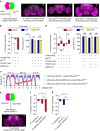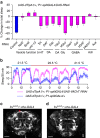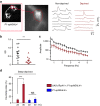Genetic and neuronal mechanisms governing the sex-specific interaction between sleep and sexual behaviors in Drosophila
- PMID: 28754889
- PMCID: PMC5533705
- DOI: 10.1038/s41467-017-00087-5
Genetic and neuronal mechanisms governing the sex-specific interaction between sleep and sexual behaviors in Drosophila
Abstract
Animals execute one particular behavior among many others in a context-dependent manner, yet the mechanisms underlying such behavioral choice remain poorly understood. Here we studied how two fundamental behaviors, sex and sleep, interact at genetic and neuronal levels in Drosophila. We show that an increased need for sleep inhibits male sexual behavior by decreasing the activity of the male-specific P1 neurons that coexpress the sex determination genes fru M and dsx, but does not affect female sexual behavior. Further, we delineate a sex-specific neuronal circuit wherein the P1 neurons encoding increased courtship drive suppressed male sleep by forming mutually excitatory connections with the fru M -positive sleep-controlling DN1 neurons. In addition, we find that FRUM regulates male courtship and sleep through distinct neural substrates. These studies reveal the genetic and neuronal basis underlying the sex-specific interaction between sleep and sexual behaviors in Drosophila, and provide insights into how competing behaviors are co-regulated.Genes and circuits involved in sleep and sexual arousal have been extensively studied in Drosophila. Here the authors identify the sex determination genes fruitless and doublesex, and a sex-specific P1-DN1 neuronal feedback that governs the interaction between these competing behaviors.
Conflict of interest statement
The authors declare no competing financial interests.
Figures










Similar articles
-
Sex-determining genes distinctly regulate courtship capability and target preference via sexually dimorphic neurons.Elife. 2020 Apr 21;9:e52701. doi: 10.7554/eLife.52701. Elife. 2020. PMID: 32314964 Free PMC article.
-
Neuroethology of male courtship in Drosophila: from the gene to behavior.J Comp Physiol A Neuroethol Sens Neural Behav Physiol. 2014 Apr;200(4):251-64. doi: 10.1007/s00359-014-0891-5. Epub 2014 Feb 25. J Comp Physiol A Neuroethol Sens Neural Behav Physiol. 2014. PMID: 24567257 Review.
-
The roles of fruitless and doublesex in the control of male courtship.Int Rev Neurobiol. 2011;99:87-105. doi: 10.1016/B978-0-12-387003-2.00004-5. Int Rev Neurobiol. 2011. PMID: 21906537 Review.
-
From fruitless to sex: On the generation and diversification of an innate behavior.Genes Brain Behav. 2021 Nov;20(8):e12772. doi: 10.1111/gbb.12772. Epub 2021 Oct 21. Genes Brain Behav. 2021. PMID: 34672079 Review.
-
Brain sex differences and function of the fruitless gene in Drosophila.J Neurogenet. 2008;22(3):309-32. doi: 10.1080/01677060802298491. J Neurogenet. 2008. PMID: 19012071 Review.
Cited by
-
The doublesex gene regulates dimorphic sexual and aggressive behaviors in Drosophila.Proc Natl Acad Sci U S A. 2022 Sep 13;119(37):e2201513119. doi: 10.1073/pnas.2201513119. Epub 2022 Sep 6. Proc Natl Acad Sci U S A. 2022. PMID: 36067320 Free PMC article.
-
Sex peptide regulates female receptivity through serotoninergic neurons in Drosophila.iScience. 2023 Feb 2;26(3):106123. doi: 10.1016/j.isci.2023.106123. eCollection 2023 Mar 17. iScience. 2023. PMID: 36876123 Free PMC article.
-
Polyphasic circadian neural circuits drive differential activities in multiple downstream rhythmic centers.Curr Biol. 2023 Jan 23;33(2):351-363.e3. doi: 10.1016/j.cub.2022.12.025. Epub 2023 Jan 6. Curr Biol. 2023. PMID: 36610393 Free PMC article.
-
To rebound or not to rebound.Elife. 2017 Oct 6;6:e31646. doi: 10.7554/eLife.31646. Elife. 2017. PMID: 28984575 Free PMC article.
-
Neurons that Function within an Integrator to Promote a Persistent Behavioral State in Drosophila.Neuron. 2020 Jan 22;105(2):322-333.e5. doi: 10.1016/j.neuron.2019.10.028. Epub 2019 Dec 3. Neuron. 2020. PMID: 31810837 Free PMC article.
References
-
- McFarland DJ. Decision making in animals. Nature. 1977;269:15–21. doi: 10.1038/269015a0. - DOI
Publication types
MeSH terms
Substances
Grants and funding
LinkOut - more resources
Full Text Sources
Other Literature Sources
Molecular Biology Databases

